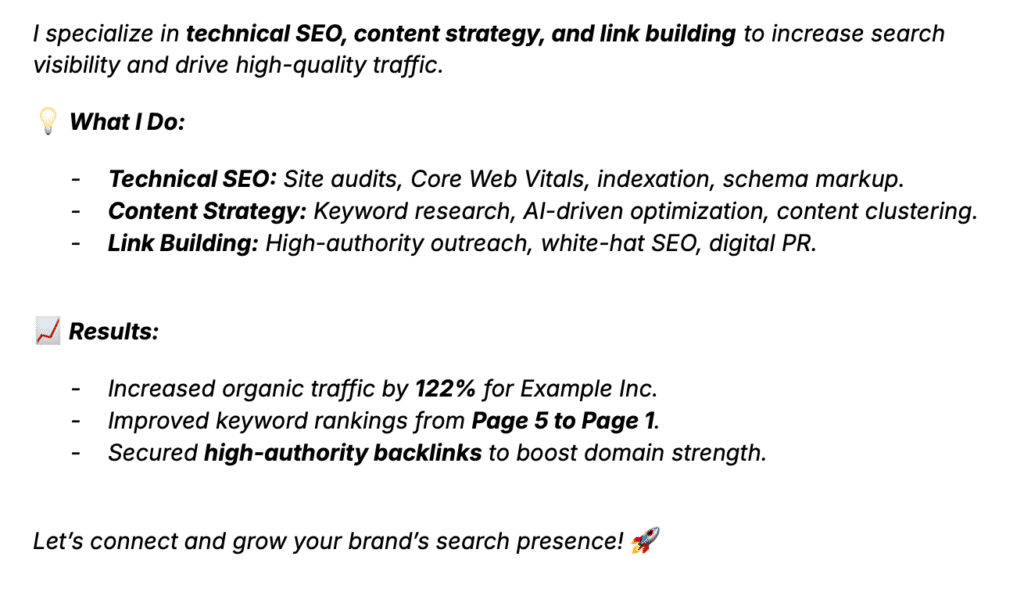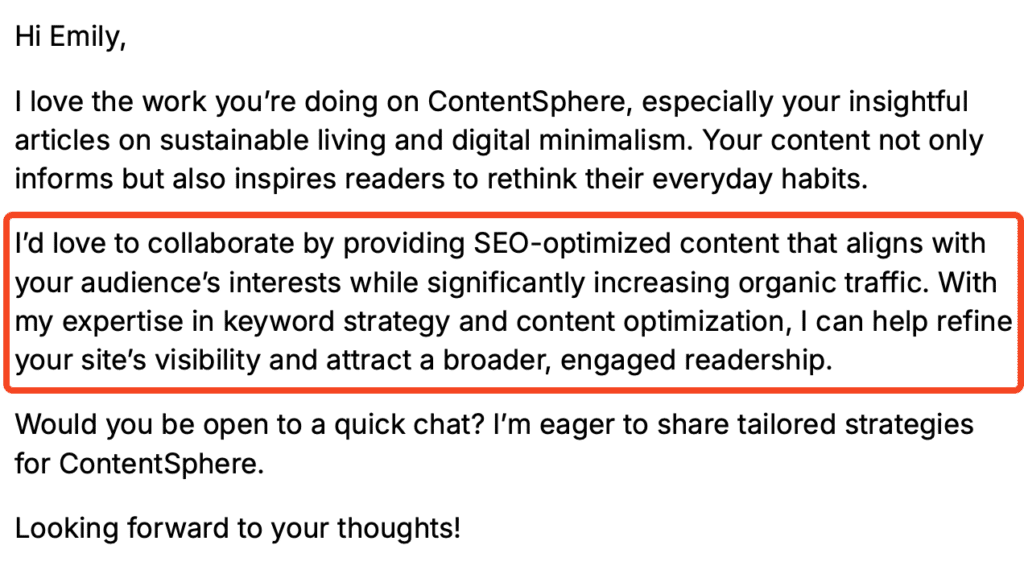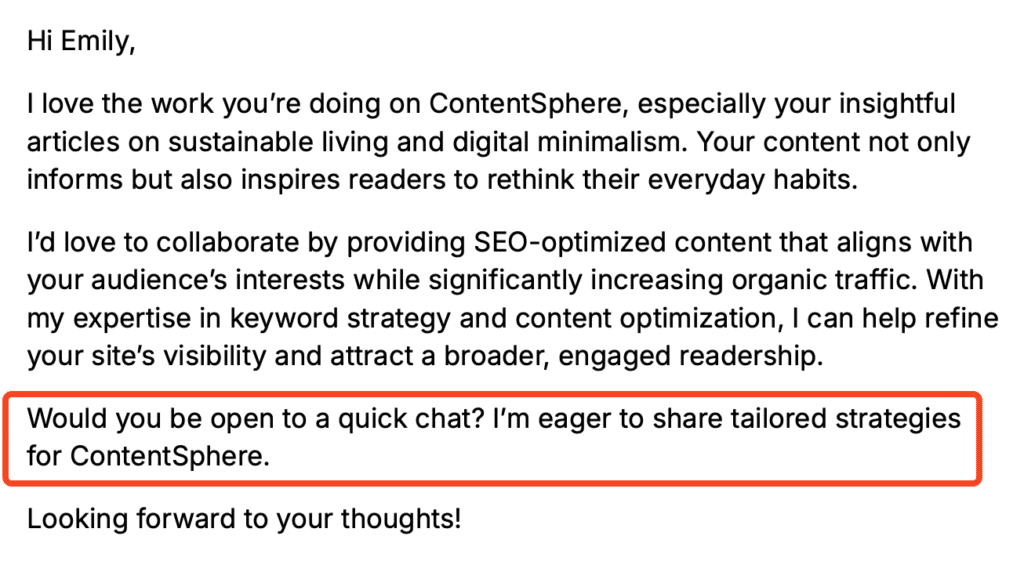
Content collaboration is an integral part of marketing and PR. Many of you run content collaboration campaigns constantly. For some, their business goal is to improve brand recognition. For others, it’s about increasing organic traffic and improving search rankings to promote business growth. So, I don’t need to tell you its value.
But, I would like to discuss using LinkedIn as a high-performance channel for your content collaboration outreach strategy, and I will help you set up your campaigns using LinkedIn.
LinkedIn is about professional networking and building mutual connections, unlike other generic social media platforms. Thus, people on LinkedIn won’t be surprised by a cold outreach about a professional matter from someone they don’t know.
Thus, this platform is a great place to find content collaboration opportunities. However, what I mentioned is not the only benefit of using LinkedIn; there are two more.
Higher Credibility of Your Messages. When you’re doing a cold outreach over email or other generic social media outlets, there’s a risk that your recipients won’t trust you. The reason is that your professional background is not visible to them, and they might consider it spam.
Let’s look at a real outreach message from a friend of ours.
Screenshot provided by the author
As we can see, LinkedIn shows the professional background of the person who has reached out to you. You can also open their profile from a Direct Message and see their experience and expertise in a certain industry.
You are more likely to trust a message like this. This is one reason LinkedIn’s cold outreach message open rate can reach up to 25%, which is three times higher than email.
Quality Prospecting. LinkedIn comes with advanced search filters that allow you to find prospects with relevant professional backgrounds, job titles, industries, locations, and more. Here’s what it looks like.
Screenshot provided by the author
Using these filters helps improve engagement — because better B2B prospecting starts with better data. Tools like the Surfe’s contact enrichment API can enrich contact records with accurate, up-to-date details so you can reach out with confidence.
For instance, you can easily find potential influencers in your industry who would feature your brand in their content. These are people with relevant experience and a comprehensive understanding of your industry. So, their content has a high level of engagement.
We already understand the value of using LinkedIn for your content collaboration efforts. So, let’s look at the process of building an effective campaign.
Here’s a simple 5-step process for getting the most out of your campaign. I created it after extensive collaboration with content collaboration outreach experts.
First impressions matter. There are two ways you will leave a positive first impression on LinkedIn. Your personalized connection request message and your LinkedIn profile.
We will discuss the outreach message in detail later, so let’s focus on your profile first.
As I mentioned earlier, LinkedIn increases your credibility by showing your expertise. You can’t take advantage of this if your LinkedIn profile does not look professional.
Lucky for us, building a professional-looking profile takes only a couple of basic steps.
Make sure that your LinkedIn profile picture presents you in a professional setting. It’s usually a headshot of you in business attire or a photo of you in a business setting.
Regarding the banner image, the best practice is to showcase your brand or the company you’re working for.
Here’s what a great combo of profile picture and banner looks like.
Credit: LinkedIn Talent Blog
It looks professional and credible, doesn’t it?
This information will appear under your profile name in the outreach message. So, make sure that it represents you from a professional standpoint.
The best practice for headlines is to showcase your position and skills in a short message (around 10 words). Something similar to this.
Screenshot provided by the author
You want the headline to be concise so it stands out in the outreach message.
On the other hand, the summary can be longer as it appears on your profile page, and you can expand to see the entire content.
The best practice is to showcase your professional skills alongside your key achievements in the field. Here’s a great example of a professional summary.

Screenshot provided by the author
Another best practice that you noticed in this summary is the call to action at the end. It’s a message that invites your profile viewers to connect with you and start a collaboration.
The last part is something that the majority of us have included on our LinkedIn profiles — listing the companies we have worked for and our respective positions. My main tip is to focus on the achievements when writing descriptions for each task, rather than the tasks themselves.
With the one element of the first impression done well, let’s look at the second one — crafting your outreach message.
There are three key elements here that you need to pay attention to.
Personalization is king. It significantly improves the quality and effectiveness of your outreach. Campaign Monitor reports a 7.6 times increase in revenue among content marketing teams that have personalized their messages through audience segmentation.
There are many ways to personalize a LinkedIn message. Basic personalization includes the prospect’s name, profession, and location.
The more advanced tactics include mentioning recent feedback on posts that the prospect made and sharing your opinion on it.
Here’s what a well-personalized outreach message will look like.
Screenshot provided by the author
In terms of the process of personalization, you can either do it manually or take advantage of LinkedIn Automated Outreach tools.
Whoever reads your outreach message will wonder what’s in it for them. Therefore, ensure that you clearly state the value they will gain by collaborating with you. Here’s a snippet from a message where the author clearly states their value.

Screenshot provided by the author
As you can see, the second paragraph in the message clearly states that the collaboration will result in an organic traffic increase.
The final element in a great outreach message is your call to action. It’s common for people to read your message and not understand what they are supposed to do next. To avoid such situations, you need to clearly state what you expect them to do after reading it.
In the previous outreach message example, we also had a clear call to action at the end.

Screenshot provided by the author
After reading this, you know that the message author wants you to discuss the tailored strategies for your blog with you.
Sending well-crafted and personalized outreach messages on LinkedIn is a great strategy. However, it is also highly time-consuming. Can you imagine researching the social posts and comments of hundreds of potential leads? Then add the time you spend crafting a personalized message for each one separately.
Luckily, you can take advantage of powerful tools specialized in LinkedIn Outreach Automation that can handle all of that hassle for you.
Specifically, automation tools such as LinkedHelper include these key features:
Apart from saving your time, LinkedIn outreach automation tools can also decrease the risk of human error. For instance, imagine that 200 prospects have not answered your message for a week. So, you need to manually send out reminder messages to all of them.
It’s fairly easy to forget to send the reminder to a couple of prospects, or send it too early or late if you’re doing all of it manually. We’re humans, we make mistakes. To streamline this process even further, businesses can also consider using trusted outreach automation tools that handle follow-ups, message sequencing, and lead management while integrating with your existing CRM workflows. These tools can significantly reduce manual workload and improve outreach consistency.
Once you have received a positive response from your outreach message, it is time to discuss the collaboration itself.
A best practice in this case is to be proactive. You can do a bit of content curation and suggest valuable content ideas yourself. The reason is that your prospects might not always have any clear ideas in their minds yet.
Some of the usual content formats you can suggest include:
No matter the type of content, make sure that whatever you’re producing creates value both for them and you.
It’s important to look at your prospects as long-term partners and your outreach as a way to develop meaningful connections. They are people that you will work with on many pieces of content instead of a one-off posting opportunity.
We asked the content specialists we work with about the benefits of long-term partnerships. They shared several reasons why they prefer long-term partnerships.
So, I suggest you look at the process of reaching out and onboarding new partners as an initial investment into a long-term relationship. It creates a productive environment for content collaboration and results in high-quality content.
Despite its numerous benefits, LinkedIn outreach automation comes with its own set of challenges, too. To help you avoid or overcome them, I will talk about two of the most common challenges, along with tested solutions for each.
Low response rates: It’s normal for your first iteration of outreach messages to underperform. It’s very common and nearly every marketer out there has faced it. It is also relatively easy to fix. Here’s what you can try:
Finding a balance between scaled automation and personalization: Even though automation tools can send personalized messages, they can’t personalize everything. So, sometimes, you need to add a more personal touch to your messages manually.
What I suggest here is to run different automation campaigns for smaller cohorts and write more relevant personalized templates for each one. This way, you will still do automated outreach while improving the level of personalization.
LinkedIn is an excellent channel for connecting with like-minded professionals and fostering professional relationships. It is a professional social network that provides you with advanced filtering tools. So, you can significantly increase the effectiveness of your outreach efforts.
Automated LinkedIn Outreach tools will help you get even better results. They can help you scale your outreach efforts while maintaining a high level of personalization in your messages.
I hope that this guide has encouraged you to try content collaboration outreach using LinkedIn. If so, the tips and best practices here will surely help you get the most out of your efforts.